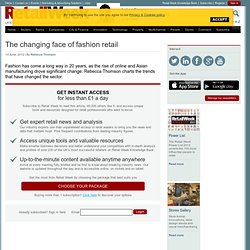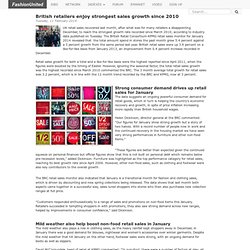

The history of computer sales in one graph. I don't put a ton of stock in the area graph, but I do think it tells the story that I generally agree with: it's pretty easy to think that tablets and smartphones are reducing our reliance on traditional computing solutions.

The fact that I've seriously considered selling my laptop at all in favor of my tablet + smartphone combo is telling enough. If someone that I'd classify as a power user (not tooting my own horn, just my perception) thinks they can reasonably get by without their computer (with trade-offs naturally) than I have to imagine that most people these days can do almost everything they want on these devices already. Online fashion clicks with Brits as market increases 152% over past five years. Some said there would be no substitute to the changing room, but new research from Mintel finds sales of online fashion have soared, increasing a staggering 152% over the last five years alone to 2010.

Indeed, in the last year alone, over one in three (35%) Brits brought their clothes at the flick of a switch, up from 26% the previous year. Valued at £4.3 billion in 2010, over the past five years, sales of online fashion have exploded. The market for online fashion is expected to reach £4.8 billion by the end of 2011. Can the British high street reinvent itself? As #c4newspopup tours Britain this week, Siobhan Kennedy travels to Swindon – once the heart of Britain’s industrial production with a thriving local economy – to find out how its high street is faring now.

My conversation with the taxi driver who took me from Swindon train station to the centre of town told me all I needed to know. He was probably a man in his 60s, had lived in Swindon all his life and yet hadn’t been on its high street for over five years. How is that possible? I asked him. Apparel textiles clothing market research - Apparel, Textiles, Clothing and Fashions Industry Market Research - Instant access to apparel, textiles and fashions market research, business analysis, industry trends, statistics, forecasts, revenues, market s.
Introduction to the Apparel & Textiles Industry While Asia, particularly China, has enjoyed a dominant position in shoes, apparel and household textiles manufacturing for several years, makers of these items located in developed nations such as the U.S. and Canada have suffered a long period of decline.

For example, over 98% of the shoes sold in America each year are imports, and the majority of these imports come from Asia. To consumers in Europe and North America, this growing reliance on Asia as a low-cost producer has meant very low retail prices for goods of reasonable quality. However, recent increases in the value of the Chinese currency, combined with rapidly rising labor costs, have put Chinese manufacturers in a much less competitive position. The changing face of fashion retail. 13 June, 2012 | By Rebecca Thomson Fashion has come a long way in 20 years, as the rise of online and Asian manufacturing drove significant change.

Rebecca Thomson charts the trends that have changed the sector. Subscribe to Retail Week to read this article, 40,000 others like it, and access unique tools and resources designed for retail professionals who want to excel. Get expert retail news and analysisOur industry experts use their unparalleled access to retail leaders to bring you the news and data that matters most. Plus frequent contributions from leading industry figures. British retailers enjoy strongest sales growth since 2010 - Management.
UK retail sales recovered last month, after what was for many retailers a disappointing December, to reach the strongest growth rate recorded since March 2010, according to industry data published on Tuesday.

The British Retail Consortium-KPMG retail sales monitor for January 2014 revealed that the total amount spend in stores the past month grew 5.4 percent against a 3 percent growth from the same period last year. British retail sales were up 3.9 percent on a like-for-like basis from January 2013, an improvement from 0.4 percent increase recorded in December. Retail sales growth for both a total and a like-for-like basis were the highest reported since April 2011, when the figures were boosted by the timing of Easter.
www.britishfashioncouncil.com/uploads/media/62/26140.pdf. www.mintel.com/en/new-consumer-trends-2014/new-trends-2014-Mintel.pdf. www.britishfashioncouncil.com/uploads/media/62/26140.pdf. British retailers enjoy strongest sales growth since 2010 - Management. Facts and Figures in the UK fashion industry - statistics about the fashion business in England - size of economic activities. Archive: Fashion industry statistics United Kingdom 14 February 2014 At a press conference to open London Fashion Week Natalie Massenet, Chairman of the British Fashion Council, announced updated figures showing substantial growth in the UK fashion industry over the past five years. - The direct value of the UK fashion industry to the UK economy is £26 billion; up from £21 billion in 2009.

Showing an increase of 22% in nominal terms (source: Oxford Economics 2014) - The UK fashion industry is estimated to support 797,000 jobs (source: Oxford Economics 2014). This is a decrease of 2.3% from 2009 - Whilst employment figures have dropped overall the increased contribution to UK GVA reflects higher productivity within the fashion sector.